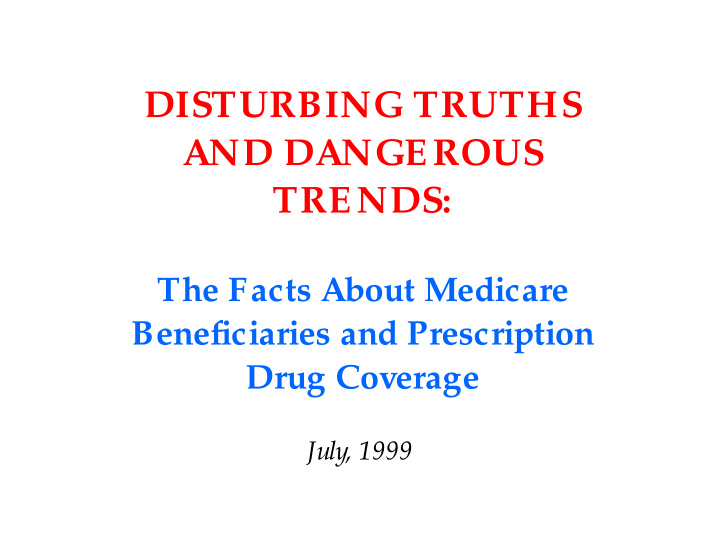



DISTURBING TRUTHS AND DANGEROUS TRENDS: The Facts About Medicare Beneficiaries and Prescription Drug Coverage July, 1999
Medicare Beneficiaries Need Prescription Drugs Beneficiaries By Total Drug Spending None 13% $1,000 + 38% $1-500 31% $500-1,000 18% SOURCE: Actuarial Research Corporation for HHS, 2000
Three Out Of Four Beneficiaries Do Not Have Solid Private Drug Coverage Distribution Of Beneficiaries 76 % By Drug Coverage 80% Other 5% Medigap 8% 60% Medicaid 12% Medicare Managed 40% Care 17% 24% 20% NO COVERAGE Retiree 34% Coverage 0% Solid Private Coverage Public/ Medigap/ No Coverage SOURCE: Actuarial Research Corporation for HHS, point-in-time, 2000
PRIVATE DRUG COVERAGE: Unstable and Declining
Retiree Health Coverage Is Declining 25% Fewer Firms Are Offering Retiree Health Benefits Firms Offering Retiree Health Coverage 50% 40% 40% 30% 30% 20% 10% 0% 1994 1998 SOURCE: Foster-Higgins, 1998
Medigap Premiums For Drugs Are High And Increase With Age, 1999 Monthly Premiums $150 $126 $125 $114 $95$105 $93 $101 $100 $83 $75 $60 $59 $56 $50 $44 $50 $25 $0 Texas New Orleans Nebraska Michigan 65 Year Olds 75 Year Olds 85 Year Olds Sample Premiums for 1999. Difference between Plans I ($1,250 benefit limit) and Plan F which is similar but has no drug coverage. These premiums will be higher in 2002, when the President’s proposed drug benefit will cost $24 per month.
Beneficiaries With Medigap Still Pay High Out-Of-Pocket Drug Costs On Top Of The Premium For The Base Medigap, Beneficiaries Pay An Extra Premium For Drugs Plus Out-Of-Pocket Spending for Drugs Medigap Annual Premiums And Out-Of-Pocket Spending $4,000 $650 Drug Out-Of- $3,000 Pocket Spending $1,201 Medigap Drug $2,000 Premium $1,932 $1,000 Base Medigap Premium $0 SOURCE: Actuarial Research Corporation for HHS. Premium from Texas for a 75 year old: base is $161 per month; drug addition is $101 per month
PUBLIC COVERAGE FOR PRESCRIPTION DRUGS
Value of Medicare Managed Care Drug Benefits Is Declining Nearly Three-Fifths Of Plans Will Cap Benefit Payments Below $1,000 In 2000 Proportion of All Plans With Limits of Less Than $1,000 59% 56% 60% 35% 40% 20% 0% 1998 1999 2000 Source: HHS analysis of plan submissions for 2000; preliminary. This includes plans with unlimited generics and limited brand name drug spending
Limits on Medicare Managed Care Drug Benefit Are Getting Lower Proportion Of Plans With A $500 Or Lower Limit Has Increased By 50% Proportion of Plans With Limit of $500 or Less 30% 28% 20% 19% 20% 10% 0% 1998 1999 2000 Source: HHS analysis of plan submissions for 2000; preliminary. This includes plans with unlimited generics and limited brand name drug spending
Participation In Medicaid Is Low Only 40% Of Eligible Beneficiaries Are Enrolled in Medicaid Eligible Medicare Beneficiaries' Enrollment in Medicaid Enrolled Eligible But Not Enrolled SOURCE: Actuarial Research Corporation for HHS. Calculated assuming that beneficiaries below 73% of poverty are eligible for full Medicaid benefits through SSI (Kaiser Commission on Medicaid & the Uninsured, May 1999)
MILLIONS OF BENEFICIARIES HAVE NO DRUG COVERAGE At Least 13 Million Medicare Beneficiaries Lack Prescription Drug Coverage
Many Uninsured In Middle Class Over Half of Medicare Beneficiaries Who Lack Prescription Drug Coverage Are In The Middle Class Income of Beneficiaries Without Drug Coverage (As A Percent Of Poverty) Less Than 100% 22% Greater Than 150% of Poverty of Poverty 54% 24% 100 to 150% of Poverty SOURCE: Actuarial Research Corporation for HHS, 2000 In 2000, poverty for a single person is about $8,500, for a couple is about $11,400
Lack of Insurance Affects All Medicare Beneficiaries Income of Beneficiaries Lacking Coverage Matches That Of All Beneficiaries 100% 6% 8% 14% 16% >$50,000 75% 18% 19% $30-50,000 $20-30,000 50% 36% 32% $10-20,000 <$10,000 25% 26% 25% 0% All Uninsured SOURCE: Actuarial Research Corporation for HHS, 2000
Methodology The Actuarial Research Corporation under contract with the Department of Health and Human Services conducted most of the analysis. The basis for the estimates is the Medicare Current Beneficiary Survey (MCBS) for 1995. These data were aged to CY 2000, converted to a point-in-time estimate, and adjusted for the increase in managed care enrollment. This enrollment increase was estimated by moving beneficiaries from retiree health coverage, Medigap and the uninsured to managed care in proportion to their enrollment in those plans.
Recommend
More recommend